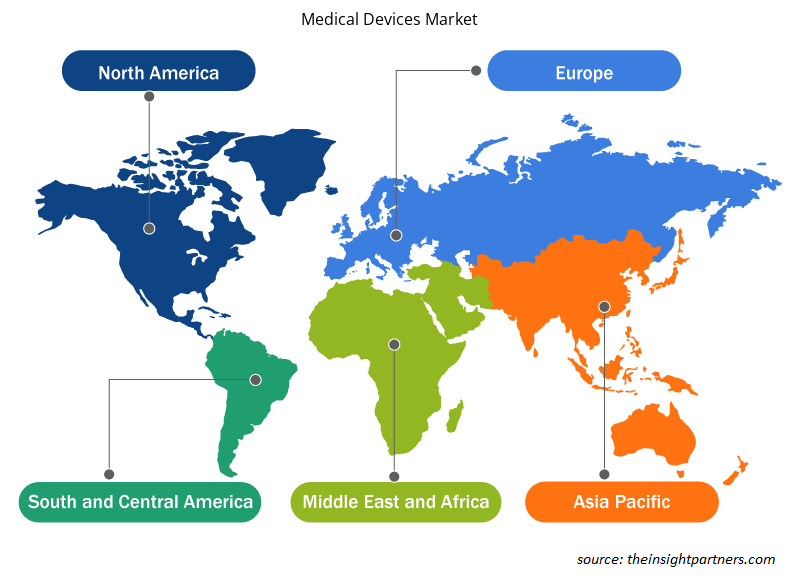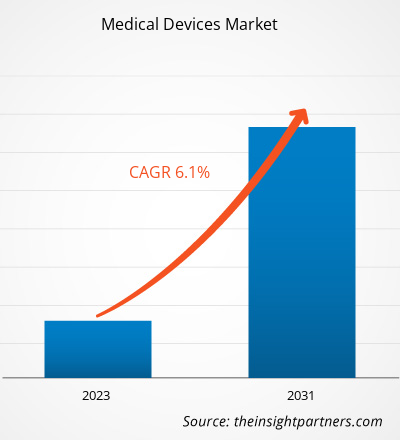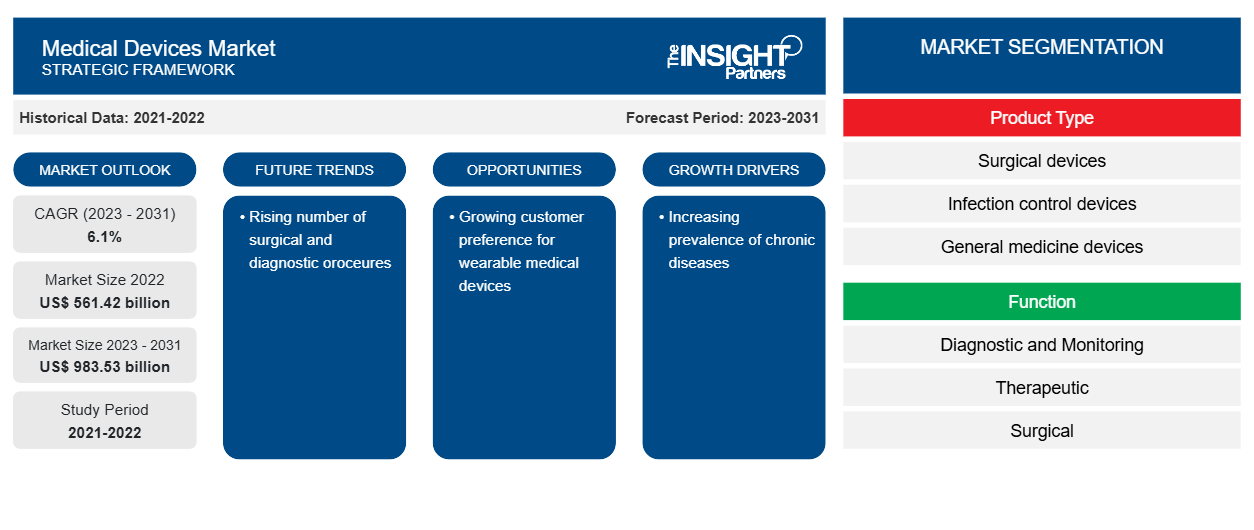Das Marktvolumen für medizinische Geräte soll von 561,42 Milliarden US-Dollar im Jahr 2022 auf 983,53 Milliarden US-Dollar im Jahr 2031 anwachsen. Für den Zeitraum 2023–2031 wird eine durchschnittliche jährliche Wachstumsrate (CAGR) von 6,1 % erwartet.
Die zunehmende Verbreitung chronischer Krankheiten, die steigende Zahl älterer Menschen, die anfällig für verschiedene chronische Krankheiten sind, und der technische Fortschritt bei medizinischen Geräten werden voraussichtlich auch weiterhin die wichtigsten Trends auf dem Markt für medizinische Geräte bleiben.
Marktanalyse für medizinische Geräte
Die Früherkennung chronischer und akuter Krankheiten und Beschwerden, die steigende Zahl geriatrischer Menschen und die rasante Entwicklung fortschrittlicher medizinischer Geräte nehmen weltweit stark zu, was zu einer erhöhten Nachfrage nach Patienten führt, die medizinische Eingriffe und Behandlungen benötigen. Dieser Faktor hat weiter zu einer Nachfrage nach medizinischen Geräten geführt, die das Management, die Diagnose und die Behandlung von Krankheiten unterstützen. Chronische Krankheiten wie Krebs, Herz-Kreislauf-Erkrankungen, Diabetes und Atemwegserkrankungen nehmen weltweit zu. Laut einem Artikel, der 2023 im A Cancer Journal for Clinicians veröffentlicht wurde, werden beispielsweise im Jahr 2023 in den Vereinigten Staaten etwa 1.958.310 neue Krebsfälle und 609.820 Krebstodesfälle erwartet. Für die Behandlung chronischer Krankheiten ist eine kontinuierliche Überwachung und Behandlung mit medizinischen Geräten wie Blutzuckermessgeräten, Blutdruckmessgeräten und Atemtherapiegeräten erforderlich, was wiederum den Gesamtmarkt antreibt.
Marktübersicht für medizinische Geräte
Nordamerika ist der größte Markt für das Wachstum des Marktes für medizinische Geräte, wobei die USA den größten Marktanteil halten, gefolgt von Kanada. Die zunehmende Alterung der Bevölkerung hat zu altersbedingten Krankheiten und Leiden geführt, die medizinische Geräte wie Hörgeräte , Gelenkersatz und Hilfsmittel erfordern, was den gesamten nordamerikanischen Markt für medizinische Geräte voraussichtlich weiter ankurbeln wird. Diese zunehmende Verbreitung von Krankheiten wird voraussichtlich das Wachstum des Marktes für medizinische Geräte im Prognosezeitraum vorantreiben. Die geriatrische Bevölkerung ist anfälliger für altersbedingte Krankheiten, die bei jüngeren Menschen weniger häufig auftreten. Laut den im Jahr 2022 im NCBI veröffentlichten Daten betrug beispielsweise die selbstberichtete Prävalenz von Herz-Kreislauf-Erkrankungen (CVDs) in der Bevölkerung über 45 Jahren 29,4 %. Ebenso stieg die Prävalenzrate mit dem Alter von 22 % in der Altersgruppe der 45- bis 54-Jährigen auf 38 % in der Altersgruppe der über 70-Jährigen, was darauf hindeutet, dass die geriatrische Bevölkerung ein hohes Risiko hat, an CVDs zu erkranken. Somit beflügelt die steigende Zahl geriatrischer Patienten in Nordamerika den Gesamtmarkt.
Passen Sie diesen Bericht Ihren Anforderungen an
Sie erhalten kostenlose Anpassungen an jedem Bericht, einschließlich Teilen dieses Berichts oder einer Analyse auf Länderebene, eines Excel-Datenpakets sowie tolle Angebote und Rabatte für Start-ups und Universitäten.
-
Holen Sie sich die wichtigsten Markttrends aus diesem Bericht.Dieses KOSTENLOSE Beispiel umfasst eine Datenanalyse von Markttrends bis hin zu Schätzungen und Prognosen.
Treiber und Chancen auf dem Markt für medizinische Geräte
Steigende Prävalenz chronischer Krankheiten, die nach medizinischen Geräten verlangen, begünstigt den Markt
Die weltweit zunehmende Belastung durch chronische Krankheiten treibt die Nachfrage nach medizinischen Geräten und Behandlungsdiensten an, die chirurgische und diagnostische Verfahren beinhalten. Laut einer von der IDF veröffentlichten Statistik von 2022 überlebten beispielsweise im Jahr 2021 in Kanada etwa 2,9 Millionen Menschen mit Diabetes. Diese Zahl soll bis 2030 bzw. 2045 auf 3,2 bzw. 3,4 Millionen ansteigen. Daher wird erwartet, dass die steigende Zahl der Diabetiker die Nachfrage nach verschiedenen tragbaren medizinischen Geräten erhöhen wird.
Technologischer Fortschritt bei medizinischen Geräten – eine Chance auf dem Markt für medizinische Geräte
Der zunehmende Fokus auf die Herstellung technologisch fortschrittlicher Medizinprodukte und die zunehmende Einführung neuer Produkte im Bereich Medizinprodukte tragen zum Marktwachstum bei. So brachte Medline UNITE im April 2022 das Calcaneal Fracture Plating System und das IM Fibula Implant auf den Markt. Das System bietet ein Fuß- und Knöcheltraumasystem aus Titan zur Behandlung nahezu aller Frakturen, die eine offene Reposition und interne Fixierung (ORIF) mit Platten- und Schraubenfixierung erfordern.
Segmentierungsanalyse des Marktberichts für medizinische Geräte
Wichtige Segmente, die zur Ableitung der Marktanalyse für medizinische Geräte beigetragen haben, sind Dienste, Dienstanbieter und Endbenutzer.
- Basierend auf dem Produkt ist der Markt für medizinische Geräte in chirurgische Geräte, In-vitro-Diagnosegeräte, Geräte für die Allgemeinmedizin, Endoskopiegeräte, Geräte zur Infektionskontrolle, Augenheilkunde, Endoskopie, Neurologie und Sonstiges unterteilt. Das IVD-Segment hatte 2023 einen größeren Marktanteil.
- Nach Funktion ist der Markt in Diagnostik und Überwachung, Therapeutik, Chirurgie und Sonstiges unterteilt. Das Segment Diagnostik und Überwachung hatte im Jahr 2023 den größten Marktanteil. Es wird jedoch erwartet, dass das chirurgische Segment im Prognosezeitraum die höchste durchschnittliche jährliche Wachstumsrate verzeichnet.
- Nach Endverbraucher ist der Markt in Krankenhäuser und Kliniken, ambulante chirurgische Zentren und andere unterteilt. Das Krankenhaussegment hatte im Jahr 2023 den größten Marktanteil und die höchste CAGR im Prognosezeitraum.
Marktanteilsanalyse für medizinische Geräte nach Geografie
Der geografische Umfang des Marktberichts für medizinische Geräte ist hauptsächlich in fünf Regionen unterteilt: Nordamerika, Asien-Pazifik, Europa, Naher Osten und Afrika sowie Südamerika/Süd- und Mittelamerika.
Nordamerika dominiert den Markt für Medizinprodukte. Das Marktwachstum ist auf die zunehmende Nutzung von Medizinprodukten in Gesundheitseinrichtungen, die wachsende Belastung durch chronische Krankheiten, hohe Gesundheitsausgaben und die Präsenz großer Hersteller von Medizinprodukten in nordamerikanischen Ländern zurückzuführen.
Neuigkeiten und aktuelle Entwicklungen zum Markt für medizinische Geräte
Der Markt für medizinische Geräte wird durch die Erhebung qualitativer und quantitativer Daten nach Primär- und Sekundärforschung bewertet, die wichtige Unternehmensveröffentlichungen, Verbandsdaten und Datenbanken umfasst. Im Folgenden finden Sie eine Liste der Entwicklungen auf dem Markt für Sprach- und Sprechstörungen sowie Strategien:
- Max Ventilator hat seine Nische durch die Einführung intelligenter Geräte wie Pulsoximeter , EKG und Monitore erweitert. Das Medizinprodukt bietet Lösungen, die Weltklassequalität zu einem erschwinglichen Preis bieten. (Quelle: Max Ventilator, Pressemitteilung/Unternehmenswebsite/Newsletter, April 2023)
- Stryker hat sein EasyFuse Dynamic Compression System auf den Markt gebracht. Das neue Fuß- und Knöchelklammersystem von Stryker wurde aus Nitinol hergestellt, einer Nickel-Titan-Legierung, die für ihre Festigkeit und Formrückgewinnung bekannt ist. Es soll die chirurgische Komplexität verringern, starke dynamische Kompressionsimplantate liefern und den Abfall im Operationssaal reduzieren. (Quelle: Stryker, Pressemitteilung/Unternehmenswebsite/Newsletter, Mai 2022)
Regionale Einblicke in den Markt für medizinische Geräte
Die regionalen Trends und Faktoren, die den Markt für Medizinprodukte im Prognosezeitraum beeinflussen, wurden von den Analysten von Insight Partners ausführlich erläutert. In diesem Abschnitt werden auch die Marktsegmente und die Geografie des Marktes für Medizinprodukte in Nordamerika, Europa, im asiatisch-pazifischen Raum, im Nahen Osten und Afrika sowie in Süd- und Mittelamerika erörtert.

- Holen Sie sich die regionalen Daten für den Markt für medizinische Geräte
Umfang des Marktberichts für medizinische Geräte
| Berichtsattribut | Details |
|---|---|
| Marktgröße im Jahr 2022 | 561,42 Milliarden US-Dollar |
| Marktgröße bis 2031 | 983,53 Milliarden US-Dollar |
| Globale CAGR (2023 - 2031) | 6,1 % |
| Historische Daten | 2021-2022 |
| Prognosezeitraum | 2023–2031 |
| Abgedeckte Segmente |
Nach Produkttyp
|
| Abgedeckte Regionen und Länder |
Nordamerika
|
| Marktführer und wichtige Unternehmensprofile |
|
Dichte der Marktteilnehmer für Medizinprodukte: Auswirkungen auf die Geschäftsdynamik verstehen
Der Markt für Medizinprodukte wächst rasant. Die Nachfrage der Endverbraucher steigt aufgrund von Faktoren wie sich entwickelnden Verbraucherpräferenzen, technologischen Fortschritten und einem größeren Bewusstsein für die Vorteile des Produkts. Mit der steigenden Nachfrage erweitern Unternehmen ihr Angebot, entwickeln Innovationen, um die Bedürfnisse der Verbraucher zu erfüllen, und nutzen neue Trends, was das Marktwachstum weiter ankurbelt.
Die Marktteilnehmerdichte bezieht sich auf die Verteilung von Firmen oder Unternehmen, die in einem bestimmten Markt oder einer bestimmten Branche tätig sind. Sie gibt an, wie viele Wettbewerber (Marktteilnehmer) in einem bestimmten Marktraum im Verhältnis zu seiner Größe oder seinem gesamten Marktwert präsent sind.
Die wichtigsten auf dem Markt für medizinische Geräte tätigen Unternehmen sind:
- Medtronic plc,
- Abbott
- Boston Scientific und Corporation,
- 3M,
- Siemens AG
- Königliche Philips
Haftungsausschluss : Die oben aufgeführten Unternehmen sind nicht in einer bestimmten Reihenfolge aufgeführt.

- Überblick über die wichtigsten Akteure auf dem Markt für medizinische Geräte
Marktbericht zu medizinischen Geräten – Umfang und Ergebnisse
Der Bericht „Marktgröße und Prognose für Medizinprodukte (2022–2030)“ bietet eine detaillierte Analyse des Marktes, die die folgenden Bereiche abdeckt:
- Marktgröße und Prognose auf globaler, regionaler und Länderebene für alle wichtigen Marktsegmente, die im Rahmen des Projekts abgedeckt sind
- Marktdynamik wie Treiber, Beschränkungen und wichtige Chancen
- Wichtige Zukunftstrends
- Detaillierte PEST/Porters Five Forces- und SWOT-Analyse
- Globale und regionale Marktanalyse mit wichtigen Markttrends, wichtigen Akteuren, Vorschriften und aktuellen Marktentwicklungen
- Branchenlandschaft und Wettbewerbsanalyse, einschließlich Marktkonzentration, Heatmap-Analyse, prominenten Akteuren und aktuellen Entwicklungen
- Detaillierte Firmenprofile
- Historische Analyse (2 Jahre), Basisjahr, Prognose (7 Jahre) mit CAGR
- PEST- und SWOT-Analyse
- Marktgröße Wert/Volumen – Global, Regional, Land
- Branchen- und Wettbewerbslandschaft
- Excel-Datensatz
Aktuelle Berichte
Verwandte Berichte
Erfahrungsberichte
Grund zum Kauf
- Fundierte Entscheidungsfindung
- Marktdynamik verstehen
- Wettbewerbsanalyse
- Kundeneinblicke
- Marktprognosen
- Risikominimierung
- Strategische Planung
- Investitionsbegründung
- Identifizierung neuer Märkte
- Verbesserung von Marketingstrategien
- Steigerung der Betriebseffizienz
- Anpassung an regulatorische Trends























 Kostenlose Probe anfordern für - Markt für medizinische Geräte
Kostenlose Probe anfordern für - Markt für medizinische Geräte